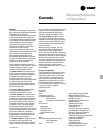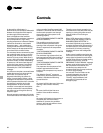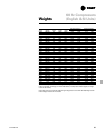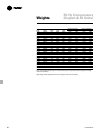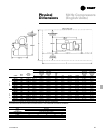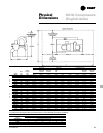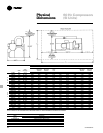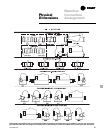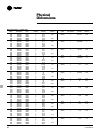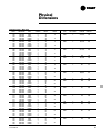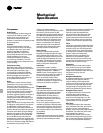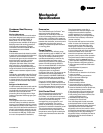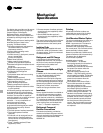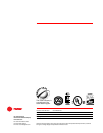
CTV-PRC007-EN48
Compressor
Guide Vanes
Fully modulating variable inlet guide
vanes provide capacity control. The
guide vanes are controlled by an
externally mounted electric vane
operator in response to refrigeration load
on the evaporator.
Impellers
Fully shrouded impellers are high
strength aluminum alloy and directly
connected to the motor rotor shaft
operating at 3,600 rpm (60 hertz),
3,000 rpm (50 hertz). Impellers are
dynamically balanced and over-speed
tested at 4,500 rpm; the motor-
compressor assembly is balanced
to a maximum vibration of .15 inch/
second at 3600 rpm as measured on the
motor housing.
Compressor Casing
Separate volute casings of refrigerant-
tight, close-grained cast iron are used on
the centrifugal compressor; each
incorporating a parallel wall diffuser
surrounded by a collection scroll. The
diffuser passages are machined to
ensure high efficiency. All casings are
proof-tested and leak-tested.
Motor
Compressor motors are hermetically
sealed two-pole, low-slip squirrel cage,
induction-type. They are built in
accordance with Trane specifications and
guaranteed by the manufacturer for
continuous operation at the nameplate
rating. A load limit system provides
protection against operation in excess of
this rating. The rotor shaft is of heat-
treated carbon steel and designed such
that the first critical speed is well above
the operating
speed. The control circuit prevents motor
energization unless positive oil pressure
is established. Impellers are keyed
directly to the motor shaft and locked in
position. Nonferrous, labyrinth-type seals
minimize recirculation and gas leakage
between the stages of the compressor.
200- through 600-volt, three-phase, 60-
hertz and 380 through 415 volt three
phase 50 hertz motors are supplied with
six terminal posts for full voltage (across-
the-line) or reduced voltage (Star-Delta or
autotransformer) starting. For low
voltage, full voltage starting —
connecting links are furnished to convert
the motor to a 3-lead motor. 2,300-
through 4,160-volt, three-phase, 60-hertz
and 3300 through 6600 volt three phase
50 hertz motors are supplied with three
terminal posts for full voltage (across-
the-line) or reduced voltage (primary
reactor or autotransformer) starting.
Motor terminal pads are supplied. A
removable sheet metal terminal box
encloses the terminal board area.
Motor Cooling
Cooling is accomplished by liquid
refrigerant pumped through the motor
with a patented refrigerant pump. The
refrigerant circulates uniformly over the
stator windings and between the rotor
and stator. The windings of all motors
are specifically insulated for operation
within a refrigerant atmosphere.
Lubrication
A direct-drive system, positive-
displacement oil pump driven by a low
voltage 3/4 horsepower, 120/60/1 or
120/50/1 motor is submerged in the oil
sump to assure a positive oil supply to
the two compressor bearings at all
times. A low watt-density heater
maintains the oil temperature which
minimizes its affinity for refrigerant. Oil
cooling is provided by refrigerant.
Evaporator
Shell and Waterboxes
The evaporator shell is formed of carbon
steel plate and incorporates a carbon
rupture disc in accordance with the
ANSI/ASHRAE 15 Safety Code. A
refrigerant temperature coupling is
provided for customer use or for use
with a low limit controller.
For all units, pass arrangements are
available at 150 psig or 300 psig water
side working pressures, with grooved
connections. Flanged connections are
also available. Marine-type waterboxes
are available.
Tube Sheets
A thick carbon steel tube sheet is welded
to each end of the shell and is drilled and
reamed to accommodate the tubes.
Mechanical
Specification
Three annular grooves are machined into
each tube hole to provide a positive
liquid and vapor seal between the
refrigerant and water side of the shell
after tube rolling. Intermediate tube
support sheets are positioned along the
length of the shell to avoid contact and
relative motion between adjacent tubes.
Tubes
Individually replaceable externally finned
seamless copper tubing, either internally
enhanced (one-inch nominal diameter)
or (three-quarter inch nominal diameter)
is utilized as the evaporator heat transfer
surface. Tubes are mechanically
expanded into the tube sheets (and
affixed to the intermediate support
sheets with the clips) to provide a leak-
free seal and eliminate tube contact and
abrasion due to relative motion.
Eliminators
Multiple layers of metal mesh screen
form the eliminators and are installed
over the tube bundle along the entire
length of the evaporator to prevent liquid
refrigerant carryover into the
compressor.
Refrigerant Distribution
A refrigerant distribution compartment in
the base of the evaporator assures
uniform wetting of the heat transfer
surface over the entire length of the shell
and under varying loads. High velocity
refrigerant spray impingement on the
tubes is prevented through this design.
Refrigerant Flow Control
A multiple orifice flow control system
maintains the correct pressure
differential between the condenser,
economizer and evaporator over the
entire range of loading. This patented
system contains no moving parts.
Shell Tests
The refrigerant side of the evaporator
shell, complete with tubes, but without
waterbox covers, is proof-tested at
45 psig, vacuum leak-tested and pressure
leak-tested. The water side of the shell,
with waterboxes in place, is
hydrostatically tested at one and one-
half times the design working pressure,
but not less than 225 psig. (These tests
are not to be repeated at installation).



